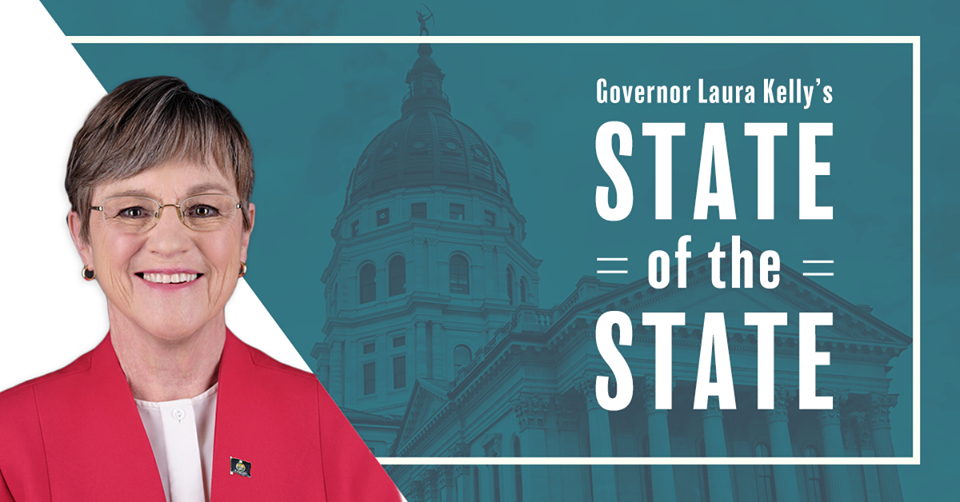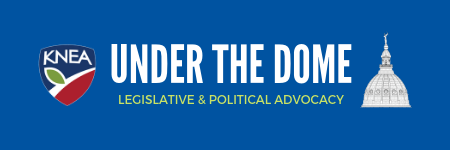Governor Laura Kelly Delivers Her Second State of the State

In her second State of the State Address, Governor Laura Kelly focused on the achievements of the last couple of years and put the credit right where it belongs – on bipartisan cooperation.
The state is in recovery from the disastrous Brownback tax experiment which was successfully reversed when moderate Republicans joined with Democrats to change direction.
It was a bipartisan effort that led to the adoption of a school finance plan that has taken the issue out of the Court for the first time in a decade. As a result, this year’s legislature convenes with a constitutional school finance formula and plans to continue into the future.
That bipartisan coalition fought off proposals to return to tax-cutting before the state had stabilized.
And to start the 2020 legislative session, there is a bipartisan agreement that can break the deadlock over Medicaid expansion and finally get health care to more than 130,000 Kansans who don’t have insurance now.
While emphasizing these positive outcomes and lauding the legislature for the hard work and cooperation, Kelly also urged them to stay the course. Kansas is not out of the woods yet. Recovery takes time. Proposals going forward need to be measured and modest.
Campbell Presents the Budget
Measured and modest is exactly what we saw when Budget Director Larry Campbell appeared before a joint meeting of the House Appropriations and Senate Ways and Means Committees.
The Governor’s budget plan is focused on restoring fiscal responsibility and addressing some vital state needs. Her budget will restore structural balance and ending balances to the budget, reduce debt, stop raiding the highway fund, keep KPERS whole, and honor the state’s commitment to our schools.
Ending balances for the next four years would exceed the statutory requirement and the Governor would use the excess money to pay off some state debt early. She also starts the phase-out of state highway fund transfers.
The Governor has again proposed re-amortizing KPERS. This is one of the more controversial aspects of the budget. It is important to understand what re-amortization does and does not do.
First, re-amortization has no impact on member benefits – it will not reduce, diminish, jeopardize, threaten, or weaken member benefits. And it does not change the authority of the KPERS Board. Campbell, in his presentation, admitted however that the KPERS Board would likely oppose re-amortization at this time.
So what does it do?
Think of it as refinancing your mortgage. When one refinances a mortgage it reduces the monthly payment but can extend the number of years over which the loan is paid. Let’s say you are in year 10 of a 30 year home loan. You refinance to get a significantly lower interest rate thus lowering your monthly payment and freeing up money for other purposes – college expenses, paying off other debt, or even just investing. At the same time, you secure the new loan for a 30 year period. You are now paying that lower payment but for an additional 10 years.
By re-amortizing KPERS, the employer contribution rates would drop from 15.23% in 2021 to 11.85%. Similar reductions would be seen in future years as well. This would reduce the state KPERS contribution in 2021 by some $130.9 million. The other side of this is that the point of equilibrium would be extended by seven years. Equilibrium is expected right now to be met in 2029 and if this re-amortization is adopted it happen in 2036.
Campbell said that re-amortization would provide KPERS payment sustainability, avoid the cliff currently projected for FY 2035, and smooth out the employer contributions to ensure payments are made in full and on time in the future.
The budget proposal also provides for some modest tax relief.
On the food sales tax, it would establish a refundable food sales tax credit for low-income individuals and families. By making the credit refundable, more Kansans would see a benefit. A refundable tax credit is one that results in a refund if the individuals do not owe taxes. For example, a single person earning less than $30,000 would be eligible for a $60 credit. If that person owes $70 in taxes, he/she only pays $10. But if that individual owes no taxes, he/she would receive a refund of $60.
The budget restores $54 million to the Local Ad Valorem Property Tax Relief Fund (LAVTR) which reduces the pressure on local units of government to raise property taxes thus providing some relief at the local level.
Two recommendations from Governor Kelly’s Council on Tax Reform would raise modest amounts of new revenue.
The first proposal is to apply the sales tax to the sale of digital goods. If you go to your local bookstore to buy a book, you pay sales tax. If you buy the same book as a digital e-book, you do not. This is seen as an unfair advantage to online vendors over neighborhood shops. This would raise $22.4 million.
The second proposal is to require marketplace facilitators to start collecting sales taxes. Kansas is one of only five states that does not do this. Marketplace facilitators are organizations that set up a portal through which multiple online retailers offer their products. If you buy something from Amazon that is not sourced by Amazon, then Amazon is acting as the marketplace facilitator and is not currently responsible for collecting the sales tax. This proposal would change that and result in $25 million more in revenue.
The promises made to K-12 schools in the last legislative session are honored in the Governor’s budget. Promised new revenues will be made available.
Click here to see Budget Director Larry Campbell’s presentation
Where does this go from here?
Bills will be introduced in both chambers where they will be debated and argued over until a final budget deal is reached late in the session. What you can be sure of, if history is any indicator, is that the final budget will be something different. Some items in her budget will make it into the final agreement, others will not. It’s a long game and we’ll be watching and reporting as it happens.
Click here to review Governor Kelly’s Budget Recommendations
Senate Ed Wraps Up Day Three of “Education by the Numbers”
After two days with Deputy Commissioner of Education Dale Dennis, KASB lobbyist Mark Tallman, and KNEA lobbyist Mark Desetti, Senator Baumgardner turned her committees’ attention to higher education.
Presenting were Blake Flanders, President, and CEO of the Kansas Board of Regents and Matt Lindsay, President of the Independent Colleges Association.
Both were asked to present information on enrollment trends in post-secondary education.
Flanders noted that there have been declines in enrollment in Kansas universities and community colleges since 2012 but that enrollment in technical colleges has soared. The independent colleges looked different in that some of the grew while others were either flat or declined.
Flanders also shared some fascinating data about the student body generally and how it does fit with the demographics of the state. For example, while 67.8% of the population of Kansas is white, 76.5% of university students are white; while 8.3% of the population is African-American, only 3.3% of university students are African-American.
We do not have access yet to an electronic copy of Flander’s presentation but if you are interested you can find much of his data points by clicking here.


